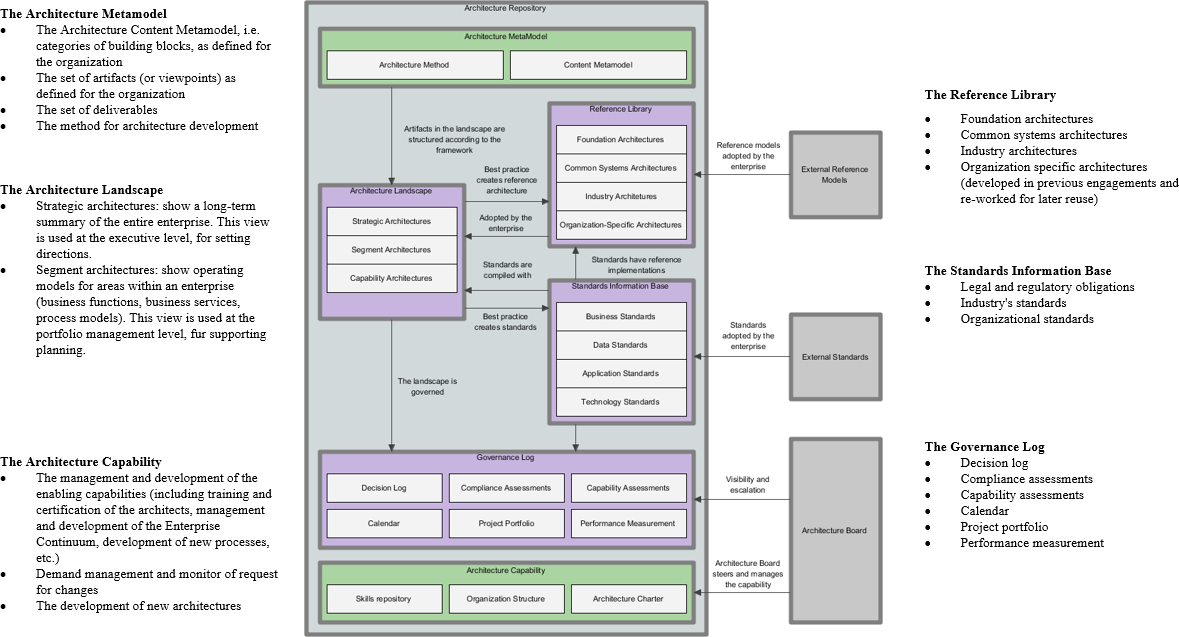Introduction
In the dynamic landscape of large enterprises, the management of architectural output becomes a critical factor in ensuring effective decision-making and seamless operations. To navigate this complex terrain, The Open Group Architecture Framework (TOGAF) introduces the concept of an Architecture Repository—a structured framework that acts as a repository for various types of architectural assets. This repository is not only a cornerstone of the wider Enterprise IT Repository but also plays a pivotal role in connecting architectural assets to components across different stages of the enterprise lifecycle.
Structural Framework
The Architecture Repository within TOGAF is designed to discern between diverse types of architectural assets existing at varying levels of abstraction within an organization. This repository serves as a tangible representation of the Enterprise Continuum—a model that classifies and organizes architectural information.

Key Components of the Architecture Repository:
At its core, the Architecture Repository encompasses six essential classes of architectural information, each playing a unique role in shaping and guiding the enterprise’s architecture capabilities:
- Architecture Metamodel: The Architecture Metamodel is the bedrock that describes how an architecture framework is applied within the organization. It outlines the method for architecture development and incorporates a metamodel for architecture content, offering a standardized approach for architectural endeavors.
- Architecture Capability: The Architecture Capability defines the parameters, structures, and processes essential for governing the Architecture Repository. It establishes a framework that supports the effective management and utilization of architectural assets, ensuring alignment with organizational goals.
- Architecture Landscape: The Architecture Landscape provides a visual representation of the building blocks currently in use within the organization. This includes a comprehensive list of live applications and other elements, allowing for multiple levels of granularity to cater to diverse architectural objectives.
- Standards Information Base: This component captures the standards that new architectures must adhere to. These standards may range from industry benchmarks to specific products and services from suppliers, or shared services already implemented within the organization. The Standards Information Base acts as a guide for ensuring compliance and uniformity.
- Reference Library: The Reference Library is a valuable resource that houses guidelines, templates, patterns, and other reference materials. Architects can leverage this repository to expedite the creation of new architectures, promoting consistency and efficiency in the development process.
- Governance Log: The Governance Log serves as a record of governance activities across the enterprise. It provides insights into the decision-making processes, ensuring transparency and accountability in architectural governance.
Architecture Repository To Be Used Across the ADM Development Phases
The following table outlines the integral role of the Architecture Repository in each phase of the ADM, emphasizing its contribution to maintaining consistency, compliance, and efficient development throughout the architecture lifecycle.
| ADM Phase | Role of Architecture Repository |
|---|---|
| Preliminary Phase | – Architecture Metamodel: Define the organization’s tailored application of the architecture framework.
– Standards Information Base: Capture initial standards and compliance requirements. |
| Phase A: Architecture Vision | – Architecture Capability: Establish parameters and processes for governing the Architecture Repository.
– Architecture Landscape: Develop an initial view of building blocks and their relationships. |
| Phase B: Business Architecture | – Architecture Landscape: Refine and expand the view of business architecture components.
– Reference Library: Utilize guidelines and templates for business architecture development. |
| Phase C: Information Systems Architecture | – Architecture Landscape: Elaborate on the architectural components related to information systems.
– Reference Library: Leverage patterns and reference materials for system architecture design. |
| Phase D: Technology Architecture | – Architecture Landscape: Extend the view to include technology architecture components.
– Standards Information Base: Ensure compliance with technology standards and specifications. |
| Phase E: Opportunities and Solutions | – Reference Library: Access guidelines and templates to expedite the creation of solution architectures.
– Governance Log: Document governance activities related to solution development. |
| Phase F: Migration Planning | – Architecture Landscape: Update the view to reflect planned migration activities.
– Reference Library: Utilize guidelines and templates for migration planning and execution. |
| Phase G: Implementation Governance | – Governance Log: Record and track governance activities related to implementation.
– Standards Information Base: Ensure ongoing compliance with standards during implementation. |
| Phase H: Architecture Change Management | – Governance Log: Continue recording and managing architecture change activities.
– Architecture Capability: Adapt parameters and processes based on lessons learned and evolving requirements. |
Conclusion
In the ever-evolving landscape of enterprise architecture, the Architecture Repository emerges as a crucial tool for organizations adopting TOGAF. By providing a structured framework and a comprehensive set of components, it enables enterprises to manage and harness the vast volume of architectural output effectively. As organizations strive for agility, innovation, and alignment with strategic goals, the Architecture Repository becomes a cornerstone in their journey towards a robust and mature architecture capability.